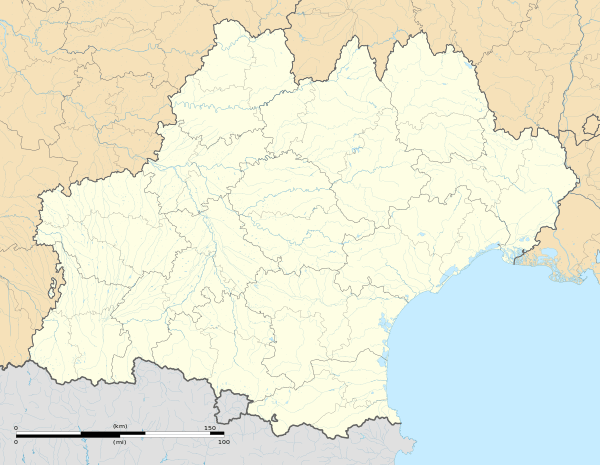Arrout
Arrout is a commune in the Ariège department in the Occitanie region of south-western France.
Arrout | |
|---|---|
A general view of Arrout | |
.svg.png) Coat of arms | |
Location of Arrout 
| |
 Arrout  Arrout | |
| Coordinates: 42°56′44″N 1°01′43″E | |
| Country | France |
| Region | Occitanie |
| Department | Ariège |
| Arrondissement | Saint-Girons |
| Canton | Couserans Ouest |
| Intercommunality | CC Couserans - Pyrénées |
| Government | |
| • Mayor (2014-2020) | Christiane Vignau |
| Area 1 | 3.02 km2 (1.17 sq mi) |
| Population (2017-01-01)[1] | 85 |
| • Density | 28/km2 (73/sq mi) |
| Time zone | UTC+01:00 (CET) |
| • Summer (DST) | UTC+02:00 (CEST) |
| INSEE/Postal code | 09018 /09800 |
| Elevation | 480–959 m (1,575–3,146 ft) (avg. 600 m or 2,000 ft) |
| 1 French Land Register data, which excludes lakes, ponds, glaciers > 1 km2 (0.386 sq mi or 247 acres) and river estuaries. | |
The inhabitants of the commune are known as Arrotois or Arrotoises[2]
Geography
Arrout is a commune in the Pyrenees mountains in the former province of Couserans some 12 km south-west of Saint-Girons and 3 km north of Castillon-en-Couserans. Access to the commune is by a country road from the end of the D404, which comes from Cescau in the south-east, to the village or by the Chemin d'Arrout from Audressein in the south. There is also a country road from Alas in the north-east. The commune is rugged and heavily forested throughout.[3]
The Lez river forms the south-eastern border of the commune as it flows north-east to join the Salat at Saint-Girons. The Cayssau stream rises in the north-west and forms the north-western border before joining the Ruisseau de Lachein. The Ruisseau de Lasquert rises in the centre of the commune and flows north-east to join the Ruisseau de Lachein which flows south-west to join the Lez.[3]
Neighbouring communes and villages[3]
Heraldry
.svg.png) Arms of Arrout |
Blazon: Quarterly, 1 and 4 Azure with a roundel of Or; 2 and 3 Argent with an eagle of Sable. |
Administration
List of Successive Mayors[4]
| From | To | Name | Party | Position |
|---|---|---|---|---|
| 2001 | 2010 | Georges Garié | ||
| 2010 | 2020 | Christiane Vignau |
(Not all data is known)
Demography
In 2010 the commune had 75 inhabitants. The evolution of the number of inhabitants is known from the population censuses conducted in the commune since 1793. From the 21st century, a census of communes with fewer than 10,000 inhabitants is held every five years, unlike larger towns that have a sample survey every year.[Note 1]
| 1793 | 1800 | 1806 | 1821 | 1831 | 1836 | 1841 | 1846 | 1851 |
|---|---|---|---|---|---|---|---|---|
| 223 | 215 | 242 | 89 | 245 | 267 | 315 | 312 | 296 |
| 1856 | 1861 | 1866 | 1872 | 1876 | 1881 | 1886 | 1891 | 1896 |
|---|---|---|---|---|---|---|---|---|
| 316 | 297 | 264 | 262 | 277 | 265 | 254 | 261 | 256 |
| 1901 | 1906 | 1911 | 1921 | 1926 | 1931 | 1936 | 1946 | 1954 |
|---|---|---|---|---|---|---|---|---|
| 251 | 204 | 202 | 166 | 145 | 125 | 110 | 103 | 85 |
| 1962 | 1968 | 1975 | 1982 | 1990 | 1999 | 2006 | 2010 | - |
|---|---|---|---|---|---|---|---|---|
| 68 | 52 | 44 | 47 | 64 | 60 | 65 | 75 | - |

Culture and Heritage
Arrout is one of the communes who received the Green Star of Esperanto from Esperanto info, an award given to mayors of communes who take a census of Esperanto speakers.
Religious Heritage
The Church contains three items that are registered as historical objects:
See also
External links
- Arrout on the National Geographic Institute website (in French)
- Arrout official website (in French)
- Arrout on Lion1906
- Arrout on Géoportail, National Geographic Institute (IGN) website (in French)
- Arrout on the 1750 Cassini Map
Notes and references
Notes
- At the beginning of the 21st century, the methods of identification have been modified by Law No. 2002-276 of 27 February 2002 Archived 6 March 2016 at the Wayback Machine, the so-called "law of local democracy" and in particular Title V "census operations" allows, after a transitional period running from 2004 to 2008, the annual publication of the legal population of the different French administrative districts. For communes with a population greater than 10,000 inhabitants, a sample survey is conducted annually, the entire territory of these communes is taken into account at the end of the period of five years. The first "legal population" after 1999 under this new law came into force on 1 January 2009 and was based on the census of 2006.
References
- "Populations légales 2017". INSEE. Retrieved 6 January 2020.
- Inhabitants of Ariège (in French)
- Google Maps
- List of Mayors of France (in French)
- Ministry of Culture, Palissy PM09000034 Chalice with Paten (in French)

- Ministry of Culture, Palissy PM09000033 Ciborium (in French)

- Ministry of Culture, Palissy PM09000021 Templar door (in French)
| Wikimedia Commons has media related to Arrout. |